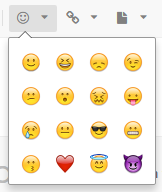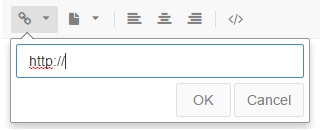Advanced Editor provides a set of formatting and style controls that can be used to customize the appearance of a discussion post.
IMPORTANT: The Advanced Editor has been moved to the Maintenance stage. Customers who are using it can continue to do so; however, Higher Logic Vanilla (Vanilla) recommends switching over to our new editor, Rich Editor.
To learn about Rich Editor, see:
Overview
Advance Editor can be set to use WYSIWYG, simple HTML, Markdown, TextEx, or BBCode. This plugin is available on all plan levels and can easily be toggled on in the ‘Addon’ menu of the Dashboard.

Important functions
Advanced Editor provides users with familiar formatting tools. Here is a quick rundown of the functions that are available.
Text formatting

This first set of buttons allows you to add bold, italic, or strikethrough tags to selected text. You can also use the standard keyboard shortcuts — Ctrl+B, Ctrl+I, and Ctrl+S — to achieve the same formatting.
Lists

These two buttons give the user the ability to start a list - using either numbers or bullet-points to mark each item in the list. After hitting one of those two options, Advanced Editor will jump you to the first point in your list. After writing the first point, hitting enter will bring you to the next point. Once you’re done with your list, just hit enter twice, and it will let you work on other aspects of your post.
Headings and special text formatting

This button provides access to a list of formats that can be applied to text and serve various functions. First, the two headings will allow for some basic text size changes:

Quote - Use this to create a block quote of your currently selected text. Quoting a post directly will automatically link back to the comment and user.
- You can enable the Quotes addon in your Dashboard to display a button on each post in your community.
Code - This allows you to place code in your post without formatting conflicts. The way this displays on your forum will depend on your theme.
- You can enable the Syntax Prettifier addon to get options to how code is displayed in your forum, allowing you to override the default CSS and add numbered lines.
Spoiler - Use this to hide content until the Show button is clicked. The Spoiler format is not visible while editing a post, even in wysiwyg. The Show/Hide toggle is visible only after the post is published.
Emoji

This button opens a panel of emojis that can be used in posts.
Adding URLs

This button allows the user to create a hyperlink within their post. After highlighting the text that needs to be a link, the user can click on this button to paste the URL into the form. Once ‘Ok’ is clicked, the highlighted text will become a link to the designated website.
Attaching images and uploading files

This next icon indicates the Attach File tool. With Advanced Editor, there are a few easy ways to attach files to a post.
The easiest way to upload is the drag-and-drop method. Dragging a file from your computer’s file explorer and hovering it over your new post will display an overlay, letting you know that you can drop it into the editor. Dropping it into the editor will immediately upload the file.
You’ll know that the file upload was successful when you see the name of the file appear in a small box underneath the comment box. Clicking the small X next to the file will remove it from the post. You can click the icon again to place it back, or save the post to remove it permanently.

After you post your comment with an attached file, other users will see the upload appear underneath your comment in box labeled with the file’s name. Clicking on the box starts an automatic download of that file to the user’s computer.

Next to attach file is the Attach Image tool. The Attach Image tool works almost identically to the File Upload tool above, except that when a user uploads an image to a post, the image is automatically embedded. .JPG, .PNG and .GIF files will be displayed.
This menu also allows you to take a URL from an image hosted on another site and embed that in the post directly.
Below is an animated example of the drag-And-drop method of image attachments. If the editor is in WYSIWYG mode, the image will appear in the editor just as it will when its posted:

For HTML, BBC, and Markdown modes, the appropriate markup for an image will be inserted where the cursor is, and the image will appear when the post is published. File types other than images that are dropped in will appear underneath the comment box.
Changing a post’s body alignment

These familiar buttons allow users to align text within their post to the left, center, or to the right, depending on their need or preference. Alignment cannot be adjusted when using Markdown, so these buttons wont appear if Advanced Editor is set to that format.
HTML view

This last button toggles HTML view for posts created in WYSIWYG for more advanced editing and format correction.

You can return to the WYSIWYG view by hitting the HTML view toggle again.
Additional settings
Advanced Editor has different modes to help you accommodate the needs of your community.
If you are an administrator, you can change the settings for the editor in the Dashboard. Go to the Posting page in dashboard settings, or navigate directly to /vanilla/settings/posting.

Posting formats
By default, all forums are set to use Markdown as their post format. Below are descriptions of each of our formats:
WYSIWYG
WYSIWYG stands for “what you see is what you get”. It is a familiar and intuitive format for most end users. In this mode, pictures and text formatting will display in the editor as the user composes their post, eliminating the need for them to understand formatting tags.
When selected, there will be an additional option to reinterpret all old posts as Wysiwyg. The purpose of this option is to normalize the editor format. If you have posts on your forum that were composed in BBC or Markdown, they will still display their formatting tags unless this box is checked.
Markdown
Markdown is a lightweight markup language that is popular and flexible. When selected for your forum, all of the formatting buttons will place the corresponding markup into the post. This article will be linked under the editor to help guide unfamiliar users.
HTML
HTML is the standard markup language of the web. This article will be linked below the editor when this mode is enabled.
BBCode
BBC is the abbreviation of Bulletin Board Code. It is a common markup language for community forums, and a great option for communities with users who are already familiar with forums. This article will be linked below the editor when this mode is enabled.
Text Ex
Text Ex is a plain text version of the editor that still allows Links, Emoji, and file attachments. Smart Embed will also still work in this mode, allowing for videos and other sharable content to be posted inline.
Text
This plain-text mode is ideal for communities that want to restrict formatting.
Mobile editor
You can choose a different format for posts made from your mobile site. Using the same format is recommended.
Additional resources
To learn about the different types of posts in Vanilla and how to create a discussion, see: